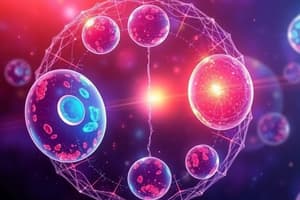Podcast
Questions and Answers
What is the primary outcome of mitosis?
What is the primary outcome of mitosis?
- Four genetically identical haploid cells
- Four genetically unique cells
- Two genetically unique haploid cells
- Two genetically identical diploid cells (correct)
Which of the following is a key distinction between meiosis and mitosis?
Which of the following is a key distinction between meiosis and mitosis?
- Meiosis produces four cells, whereas mitosis produces two cells (correct)
- Mitosis involves two rounds of division, while meiosis involves one
- Mitosis produces haploid cells, while meiosis produces diploid cells
- Mitosis results in genetically unique cells, while meiosis results in identical cells
What role do tumor suppressor genes play in the cell cycle?
What role do tumor suppressor genes play in the cell cycle?
- They enhance the division rate of normal cells
- They regulate the cell cycle and prevent uncontrolled growth (correct)
- They trigger cellular apoptosis under all circumstances
- They promote uncontrolled cell division when overactive
What is the effect of mutations in proto-oncogenes?
What is the effect of mutations in proto-oncogenes?
How does meiosis contribute to sexual reproduction?
How does meiosis contribute to sexual reproduction?
What occurs during the S phase of the cell cycle?
What occurs during the S phase of the cell cycle?
During which phase does the reformation of nuclear envelopes occur?
During which phase does the reformation of nuclear envelopes occur?
What is the primary function of the G1/S checkpoint?
What is the primary function of the G1/S checkpoint?
What is the consequence of damaged DNA detected at the G2/M checkpoint?
What is the consequence of damaged DNA detected at the G2/M checkpoint?
Which stage of mitosis involves the alignment of chromosomes along the metaphase plate?
Which stage of mitosis involves the alignment of chromosomes along the metaphase plate?
What role do cyclins and cyclin-dependent kinases (CDKs) play in the cell cycle?
What role do cyclins and cyclin-dependent kinases (CDKs) play in the cell cycle?
What event marks the separation of sister chromatids during mitosis?
What event marks the separation of sister chromatids during mitosis?
What is the primary purpose of cytokinesis?
What is the primary purpose of cytokinesis?
Flashcards
Mitosis
Mitosis
Cell division producing two genetically identical daughter cells with the same number of chromosomes as the parent cell.
Meiosis
Meiosis
Cell division producing four genetically unique daughter cells with half the number of chromosomes as the parent cell.
Cancer
Cancer
Uncontrolled cell growth and division leading to the formation of tumors.
Tumor suppressor genes
Tumor suppressor genes
Signup and view all the flashcards
Proto-oncogenes
Proto-oncogenes
Signup and view all the flashcards
Cell Cycle
Cell Cycle
Signup and view all the flashcards
Interphase
Interphase
Signup and view all the flashcards
Mitotic (M) Phase
Mitotic (M) Phase
Signup and view all the flashcards
G1 Phase (Gap 1)
G1 Phase (Gap 1)
Signup and view all the flashcards
S Phase (Synthesis)
S Phase (Synthesis)
Signup and view all the flashcards
G2 Phase (Gap 2)
G2 Phase (Gap 2)
Signup and view all the flashcards
Cell Cycle Checkpoints
Cell Cycle Checkpoints
Signup and view all the flashcards
G1/S Checkpoint
G1/S Checkpoint
Signup and view all the flashcards
Study Notes
The Cell Cycle
- The cell cycle is a series of events leading to cell growth and division.
- It's a continuous process, divided into interphase and the mitotic (M) phase for study.
- Interphase, the longest phase, has three sub-phases: G1, S, and G2.
- G1: Cell growth, protein synthesis for DNA replication.
- S phase: DNA replication for daughter cell copies.
- G2: Continued growth, protein synthesis for cell division.
- The M phase (Mitosis): Nuclear division and cytokinesis, two identical daughter cells.
- Mitosis stages: prophase, metaphase, anaphase, and telophase.
- Prophase: Chromosome condensation, mitotic spindle formation.
- Metaphase: Chromosomes align on the metaphase plate.
- Anaphase: Sister chromatids separate, move to opposite poles.
- Telophase: Nuclear envelopes reform around separated chromosomes.
- Cytokinesis: Cytoplasm division, completing cell division.
- Cell cycle regulation is crucial for health and preventing uncontrolled growth (cancer).
- Checkpoints at various stages ensure accuracy, preventing DNA replication and chromosome segregation errors.
- Cyclin-dependent kinases (CDKs) and cyclins regulate the cell cycle.
Cell Cycle Checkpoints
- Checkpoints ensure accurate DNA replication and chromosome segregation.
- Checkpoints monitor cell size, DNA replication completion, and chromosome alignment.
- DNA damage triggers cell cycle arrest for repair.
- G1/S checkpoint: Cell size, DNA integrity before replication.
- G2/M checkpoint: DNA replication completion, damage repair before mitosis.
- Spindle assembly checkpoint: Chromosome attachment to spindle, proper segregation.
Types of Cell Division
- Mitosis produces two genetically identical diploid daughter cells from a single diploid parent cell. It's for growth, repair, and asexual reproduction.
- Meiosis produces four genetically unique haploid daughter cells from a diploid parent cell. It's essential for sexual reproduction.
- Mitosis and meiosis differ by the number of divisions and genetic makeup of daughter cells.
Cancer and the Cell Cycle
- Cancer is uncontrolled cell growth and division.
- Disruptions in cell cycle regulation mechanisms can cause cancer.
- Mutated or deactivated tumor suppressor genes (e.g., p53) and proto-oncogenes lead to uncontrolled division.
Studying That Suits You
Use AI to generate personalized quizzes and flashcards to suit your learning preferences.




